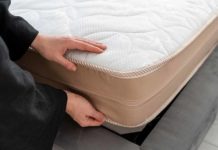
There is little evidence of the use of wallpaper in homes in the United States before the mid-eighteenth century. Before that time, the walls in American homes were treated with finishes such as whitewash, paint, wainscot, and for the more elite, panels of fabric. The 1880’s marked a time of wallpaper popularity in the U.S and the walls in homes were decorated, no matter the size of the room. Since that time, papering walls, has been a popular choice for wall coverings in American homes.
When this wall covering choice was first created, it was necessary to purchase a dry paste of sorts, to which water was added and mixed to form the glue. This was then used to attach the paper to the wall area. In more recent times however, a pre-pasted paper has been made. To install, just wet the backside of the paper, trim, adjust and smooth flat. Although homes can be beautified in this manner, removing this form of wall decoration can be intense. So be sure you are ready to sweat and give up your time. Wallpaper can seem a little stubborn to remove!
While papered walls can look beautiful, perhaps you are tired of your last decorating theme. Or maybe you’ve purchased a home where the last owner’s idea of what beautifully papered walls are. Either way, you’ve decided you want to remove the paper. What do you do?
Some people may lack the ambition or desire to remove the wallpaper and decide to either paint or paper over the existing wall covering. While there is nothing wrong with this, removing the paper completely will ensure a better finished wall and a smoother end result.
One of the main concerns you’ll have when removing wallpaper, is how to remove the paper without causing damage to your walls. Options include, using a steamer or using chemicals. You’ll need to decide which one will work best for you. Removing the paper isn’t necessarily difficult, but it can be very time consuming. Believe it or not, there’s a real art to stripping wallpaper from your walls and patience must be exercised.
Depending on the type of paper that has been installed, some can be removed dry. Others may need a removal solution. Basically, it really depends on the method of installation used. If the wall wasn’t sealed with a primer, you may experience damage to the wall’s texture or sheetrock which must be repaired before decorating the wall again, can take place.
In the olden days, steamers heated with a propane tank were used to remove wallpaper. Now days, electric steamers can be rented. A word of caution though is that there is a good chance of getting burned or scalded while using a steamer. Special care should be taken to protect your hands with thick heat resistant gloves and children and pets should be kept out of the area during the time a steamer is in use.
A better way to remove wallpaper is to use chemicals. It will take half the time as a steamer and is much safer. A concentrated chemical that is mixed with hot water becomes a solution that dissolves the glue on the paper backing.
When starting this project, be sure to have all the necessary tools on hand. These include a broad knife, a ladder, a scoring tool, and a two gallon plastic pump garden sprayer. Also, be sure to have a couple of drop cloths available to protect your flooring. Remove all outlet covers and then mix the chemical solution with hot water. There may be other products available, but a reputable one is DIF by Zinsser. This product may be purchased at your local home improvement store.
Begin by spraying a small area of your wall and pulling on the paper to see which direction the glue grain is going. You can experiment by moving the paper in all directions. If the paper still seems to be stuck fast to the wall, spray the area once again and allow the solution to wet the area thoroughly.
As you pull the paper off the wall, if only the top layer comes off, score the remaining paper gently and spray the wall again. This will allow the solution to be absorbed in the area where the glue is. Wait a few minutes and once again, pull the wall covering in the direction of the glue grain. This should remove the wallpaper in a clean neat manner.
Don’t be startled if you find another layer of paper underneath the first. This is especially true if your home is older. Actually, its kind of exciting to view the different choices others have made for their walls throughout history. Be sure to remove only one layer at a time to avoid damage to your walls. As the paper comes off, spray the solution one last time and gently scrape any areas that may need any extra help. The last step is to wipe the wall area with a damp clean sponge and let it dry for a couple of days before painting or papering.
There are also home remedies for removing wallpaper. These include using white vinegar and fabric softener. Both need to be added to, as hot of water as you can stand working with. They are then sponged on the wall in a wet manner or sprayed on the wall using the same techniques as the chemical remover. There are also many bio-degradable and environmentally safe removers available. Shop on line or ask your local home care expert for advise.
Papering a wall is a wonderful choice for any home’s décor. Both the rich and poor, paper their walls. A man from a low income family in the south, told me that years ago, his folks used the discarded comic strips out their local newspaper to paper their walls. And although, you can find it for less than ten dollars a roll, the most expensive wall covering known in the United States was purchased by President John F. Kennedy’s wife, Jacqueline. This wallpaper was manufactured from a French company, and cost almost $29,000 dollars. Wow!!! It was installed in the White House and can still be seen today.





